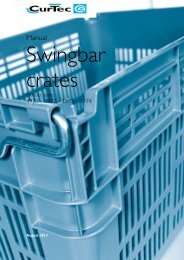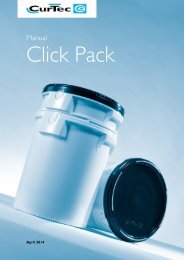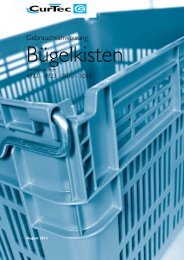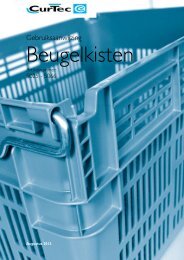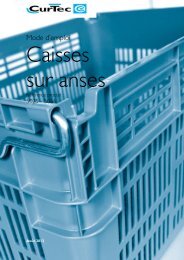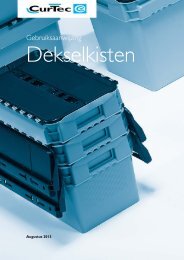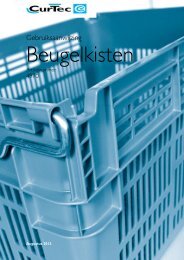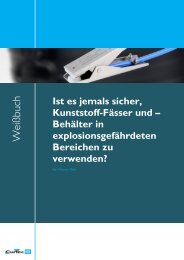Is it ever safe to use plastic drums and containers in ... - CurTec
Is it ever safe to use plastic drums and containers in ... - CurTec
Is it ever safe to use plastic drums and containers in ... - CurTec
You also want an ePaper? Increase the reach of your titles
YUMPU automatically turns print PDFs into web optimized ePapers that Google loves.
Wh<strong>it</strong>e paper<br />
<strong>Is</strong> <strong>it</strong> <strong>ever</strong> <strong>safe</strong> <strong>to</strong> <strong>use</strong><br />
<strong>plastic</strong> <strong>drums</strong> <strong>and</strong><br />
<strong>conta<strong>in</strong>ers</strong> <strong>in</strong> hazardous<br />
areas?<br />
by Newson Gale<br />
www.curtec.com
Introduction<br />
In recent years there has been a proliferation of new <strong>and</strong> low cost <strong>plastic</strong> portable<br />
<strong>conta<strong>in</strong>ers</strong>. Conta<strong>in</strong>ers rang<strong>in</strong>g <strong>in</strong> size from 1 l<strong>it</strong>re bottles, <strong>to</strong> 220 l<strong>it</strong>re <strong>drums</strong> <strong>and</strong><br />
1000 l<strong>it</strong>re IBCs have provided the supply cha<strong>in</strong>s of the hazardous process<br />
<strong>in</strong>dustries w<strong>it</strong>h a diverse range of material packag<strong>in</strong>g options.<br />
While some packag<strong>in</strong>g options will require <strong>plastic</strong>s that demonstrate specific levels<br />
of material compatibly w<strong>it</strong>h different products, one of the major drivers of <strong>plastic</strong><br />
packag<strong>in</strong>g is their relative low cost <strong>in</strong> comparison <strong>to</strong> metal <strong>conta<strong>in</strong>ers</strong> <strong>in</strong>clud<strong>in</strong>g<br />
metal <strong>drums</strong> <strong>and</strong> metal IBCs. The <strong>in</strong>creas<strong>in</strong>g <strong>use</strong> of <strong>plastic</strong> <strong>conta<strong>in</strong>ers</strong> w<strong>it</strong>h<strong>in</strong> the<br />
hazardous process <strong>in</strong>dustries is com<strong>in</strong>g under <strong>in</strong>creas<strong>in</strong>g scrut<strong>in</strong>y due <strong>to</strong> the<br />
hazards associated w<strong>it</strong>h static electric<strong>it</strong>y.<br />
This brief article will address the issues associated w<strong>it</strong>h static electric<strong>it</strong>y on <strong>plastic</strong><br />
packag<strong>in</strong>g, draw on reports <strong>and</strong> expertise of <strong>in</strong>dustry <strong>and</strong> <strong>safe</strong>ty bodies <strong>and</strong><br />
provide solutions <strong>to</strong> ground<strong>in</strong>g non-metallic <strong>conta<strong>in</strong>ers</strong>, w<strong>it</strong>h a particular focus on<br />
compos<strong>it</strong>e <strong>drums</strong> <strong>and</strong> IBCs.<br />
Def<strong>in</strong><strong>in</strong>g the mean<strong>in</strong>g of the terms ‘static dissipative’,<br />
‘conductive’ <strong>and</strong> ‘<strong>in</strong>sulat<strong>in</strong>g’<br />
It is important <strong>to</strong> def<strong>in</strong>e the terms ‘conductive’, ‘<strong>in</strong>sulat<strong>in</strong>g’ <strong>and</strong> ‘static dissipative’<br />
(anti-static) <strong>in</strong> order <strong>to</strong> fully appreciate the capabil<strong>it</strong>y of materials <strong>to</strong> <strong>safe</strong>ly<br />
dissipate electrostatic charges from objects that are correctly earthed (grounded).<br />
Conductive materials perm<strong>it</strong> the transfer of electrostatic charges <strong>in</strong>stantaneously.<br />
In static dissipative materials, electrostatic charges are adequately dissipated, albe<strong>it</strong><br />
at a slower rate than conductive materials. In <strong>in</strong>sulat<strong>in</strong>g materials, or <strong>to</strong> be more<br />
precise, poorly conduct<strong>in</strong>g materials, electrostatic charges tend <strong>to</strong> be reta<strong>in</strong>ed on<br />
the material <strong>and</strong> not readily transferred, even when the material is connected <strong>to</strong><br />
earth.<br />
Underst<strong>and</strong><strong>in</strong>g the difference between volume resistance <strong>and</strong> surface resistance is<br />
also important. Resistiv<strong>it</strong>y is determ<strong>in</strong>ed by the <strong>in</strong>tr<strong>in</strong>sic properties of a material<br />
that resist the flow of electrical currents. Volume resistiv<strong>it</strong>y, ρ, represents the<br />
<strong>to</strong>tal resistiv<strong>it</strong>y value of a section of material through <strong>it</strong>s entire volume. The<br />
overall resistance <strong>to</strong> charge transfer is calculated by multiply<strong>in</strong>g the resistiv<strong>it</strong>y<br />
value for the material by <strong>it</strong>s length <strong>and</strong> divid<strong>in</strong>g by the cross sectional area through<br />
which the charge is flow<strong>in</strong>g.<br />
R = ρl/A<br />
For example, the resistance through a large volume of 1 m length by 1m 2 cross<br />
sectional area of PTFE w<strong>it</strong>h a resistiv<strong>it</strong>y (ρ) value of 10 19 Ω.m, is equal <strong>to</strong> 1x10 19<br />
ohms. For a similar volume of copper w<strong>it</strong>h a resistiv<strong>it</strong>y value of 1x10 -8 Ω.m, the<br />
Wh<strong>it</strong>e paper | <strong>Is</strong> <strong>it</strong> <strong>ever</strong> <strong>safe</strong> <strong>to</strong> <strong>use</strong> <strong>plastic</strong> <strong>drums</strong> <strong>and</strong> <strong>conta<strong>in</strong>ers</strong> <strong>in</strong> hazardous areas?
esistance through the copper will be 1x10 -8 ohms. So even if the PTFE is<br />
correctly earthed, charges will experience a very high degree of resistance <strong>to</strong><br />
their movement <strong>to</strong> earth, whereas as for metals, charges will experience l<strong>it</strong>tle or<br />
no resistance <strong>and</strong> be transferred <strong>to</strong> earth immediately.<br />
Resistance experienced by current flow<strong>in</strong>g through material is <strong>in</strong>fluenced by<br />
the resistiv<strong>it</strong>y value, ρ, for the material <strong>and</strong> the length <strong>and</strong> cross-sectional<br />
area of the material.<br />
Surface resistiv<strong>it</strong>y, λ, represents the <strong>to</strong>tal resistiv<strong>it</strong>y across the surface of a<br />
material. In essence, a material w<strong>it</strong>h a high volume resistiv<strong>it</strong>y could be eng<strong>in</strong>eered<br />
<strong>to</strong> have a low surface resistiv<strong>it</strong>y value, mean<strong>in</strong>g charges that would otherwise not<br />
transfer easily through the material, are allowed <strong>to</strong> transfer across <strong>it</strong>s surface.<br />
Overall surface resistance is calculated <strong>in</strong> a similar way, where the resistance is<br />
calculated from R = λ L /L.<br />
Resistance experienced by current flow<strong>in</strong>g across surface is <strong>in</strong>fluenced by the<br />
surface resistiv<strong>it</strong>y value of the material <strong>and</strong> the length <strong>and</strong> breadth of the<br />
material.<br />
Wh<strong>it</strong>e paper | <strong>Is</strong> <strong>it</strong> <strong>ever</strong> <strong>safe</strong> <strong>to</strong> <strong>use</strong> <strong>plastic</strong> <strong>drums</strong> <strong>and</strong> <strong>conta<strong>in</strong>ers</strong> <strong>in</strong> hazardous areas?
In general materials can be segmented <strong>in</strong><strong>to</strong> three categories, depend<strong>in</strong>g on their<br />
volume <strong>and</strong> surface resistiv<strong>it</strong>y values.<br />
Material classification Volume resistiv<strong>it</strong>y, (ρ), Ω.m Surface resistiv<strong>it</strong>y, (λ), Ω/sq<br />
Conductive ρ < 10 2 λ < 10 5<br />
Dissipative 10 2 ≤ ρ < 10 9 10 5 ≤ λ < 10 12<br />
Insulat<strong>in</strong>g ρ ≥ 10 9 λ ≥ 10 12<br />
Table 1: range of resistiv<strong>it</strong>y values for conductive, static dissipative <strong>and</strong><br />
<strong>in</strong>sulat<strong>in</strong>g materials (1)<br />
In regard <strong>to</strong> electrostatic ign<strong>it</strong>ion hazards w<strong>it</strong>h<strong>in</strong> hazardous areas the correct <strong>use</strong><br />
<strong>and</strong> specification of <strong>conta<strong>in</strong>ers</strong> made from conductive, static dissipative <strong>and</strong><br />
<strong>in</strong>sulat<strong>in</strong>g materials is cr<strong>it</strong>ical <strong>to</strong> the <strong>safe</strong>ty of workers <strong>and</strong> the processes <strong>in</strong> which<br />
these <strong>conta<strong>in</strong>ers</strong> are <strong>use</strong>d.<br />
Test<strong>in</strong>g of compos<strong>it</strong>e IBCs <strong>and</strong> <strong>in</strong>dustry guidance<br />
A report prepared for the Health & Safety Executive <strong>in</strong> the UK highlights key<br />
selection cr<strong>it</strong>eria hazardous area opera<strong>to</strong>rs should take <strong>in</strong><strong>to</strong> consideration when<br />
us<strong>in</strong>g portable <strong>conta<strong>in</strong>ers</strong> w<strong>it</strong>h<strong>in</strong> hazardous areas (2) . The report tested <strong>and</strong><br />
quantified the levels of electrostatic discharge on <strong>conta<strong>in</strong>ers</strong> rang<strong>in</strong>g <strong>in</strong> size from<br />
small 1 l<strong>it</strong>re <strong>plastic</strong> bottles <strong>to</strong> 1000 l<strong>it</strong>re rigid IBCs. Rigid IBCs are supplied <strong>in</strong> a<br />
wide range of different materials of construction <strong>and</strong> can be made of <strong>in</strong>sulat<strong>in</strong>g<br />
<strong>plastic</strong>, static dissipative <strong>plastic</strong>, <strong>and</strong> <strong>in</strong>sulat<strong>in</strong>g <strong>plastic</strong>s surrounded by metal sheet<br />
cladd<strong>in</strong>g or steel frames. 220 l<strong>it</strong>re <strong>plastic</strong> <strong>drums</strong> were not <strong>in</strong>cluded <strong>in</strong> these tests.<br />
The generation <strong>and</strong> measurement of electrostatic discharge was conducted <strong>in</strong><br />
accordance w<strong>it</strong>h BS EN 13463-1:2001 ‘Non-electrical equipment for <strong>use</strong> <strong>in</strong><br />
potentially explosive atmospheres. Basic method <strong>and</strong> requirements’.<br />
Controlled labora<strong>to</strong>ry test<strong>in</strong>g highlighted that levels of electrostatic discharge<br />
capable of ign<strong>it</strong><strong>in</strong>g commonly <strong>use</strong>d gases <strong>and</strong> vapours is possible from all conta<strong>in</strong>er<br />
types. A <strong>plastic</strong> compos<strong>it</strong>e IBC, manufactured w<strong>it</strong>h a static dissipative outer layer<br />
was tested <strong>and</strong> this demonstrated <strong>safe</strong> electrostatic discharge levels, how<strong>ever</strong>, the<br />
report does <strong>in</strong>dicate that a representative sample would need <strong>to</strong> be tested <strong>to</strong><br />
determ<strong>in</strong>e if these characteristics are consistent.<br />
Just some, of a number of the report’s conclusions <strong>and</strong> recommendations, are<br />
listed below:<br />
Wh<strong>it</strong>e paper | <strong>Is</strong> <strong>it</strong> <strong>ever</strong> <strong>safe</strong> <strong>to</strong> <strong>use</strong> <strong>plastic</strong> <strong>drums</strong> <strong>and</strong> <strong>conta<strong>in</strong>ers</strong> <strong>in</strong> hazardous areas?
� ‘It is very important w<strong>it</strong>h all designs that the frame <strong>and</strong> any other<br />
conduct<strong>in</strong>g parts are electrically bonded <strong>to</strong> earth dur<strong>in</strong>g any operation<br />
where electrostatic charg<strong>in</strong>g may occur <strong>and</strong> that they should not be<br />
s<strong>to</strong>red on a highly <strong>in</strong>sulat<strong>in</strong>g surface unless separately earthed’.<br />
� The earth connection between the frame <strong>and</strong> conduct<strong>in</strong>g parts of taps<br />
should be checked at regular <strong>in</strong>tervals.<br />
� Exposed <strong>plastic</strong> components (e.g. taps <strong>and</strong> fill<strong>in</strong>g caps) should be made of<br />
static dissipative materials.<br />
� Metal frames <strong>and</strong> conduct<strong>in</strong>g objects located on IBCs should be<br />
‘electrically bonded <strong>to</strong> earth’ w<strong>it</strong>h a sufficient charge relaxation time<br />
perm<strong>it</strong>ted.<br />
� A thorough risk assessment should be carried out <strong>to</strong> determ<strong>in</strong>e the most<br />
appropriate type of conta<strong>in</strong>er w<strong>it</strong>h a particular focus on electrostatic<br />
charg<strong>in</strong>g potentials <strong>and</strong> the presence of flammable gases <strong>and</strong> vapours <strong>in</strong><br />
the IIA, IIB <strong>and</strong> IIC categories.<br />
Given the overwhelm<strong>in</strong>g number <strong>and</strong> availabil<strong>it</strong>y of IBC options, the SIA <strong>and</strong> CBA<br />
issued ‘Guidance Notice 51a’ which describes the key selection cr<strong>it</strong>eria for e<strong>it</strong>her<br />
sta<strong>in</strong>less steel or compos<strong>it</strong>e IBCs w<strong>it</strong>h an anti-static sheet’’. The IBC selection<br />
cr<strong>it</strong>eria pr<strong>in</strong>cipally depends on the flash po<strong>in</strong>t of the solvent be<strong>in</strong>g <strong>use</strong>d <strong>and</strong><br />
whether the solvent can be def<strong>in</strong>ed as hav<strong>in</strong>g electrically conductive or resistive<br />
characteristics. More detailed <strong>in</strong>formation can seen <strong>in</strong> the guidance notice, but a<br />
table list<strong>in</strong>g IBC options for resistive solvents (hydrocarbons), <strong>and</strong> conductive<br />
solvents (oxygenated), are summarised <strong>in</strong> the follow<strong>in</strong>g table:<br />
IBC type<br />
Solvent flash po<strong>in</strong>t<br />
40°C<br />
Compos<strong>it</strong>e w<strong>it</strong>h anti-static<br />
sheath<br />
No<br />
No: hydrocarbons<br />
Yes: oxygenated<br />
Yes<br />
Sta<strong>in</strong>less steel Yes Yes Yes<br />
Table 2: Parameters determ<strong>in</strong><strong>in</strong>g appropriate selection of sta<strong>in</strong>less steel <strong>and</strong><br />
compos<strong>it</strong>e IBCs manufactured w<strong>it</strong>h static dissipative sheaths (3) .<br />
St<strong>and</strong>ards <strong>and</strong> practical advice<br />
The ma<strong>in</strong> issue w<strong>it</strong>h fill<strong>in</strong>g non-conductive <strong>plastic</strong> <strong>conta<strong>in</strong>ers</strong> whether <strong>it</strong> is IBCs,<br />
<strong>drums</strong> or bottles is that the liquid or solid, which is charged through <strong>it</strong>s own<br />
movement, will <strong>in</strong>duce charges on the <strong>plastic</strong>. As the conta<strong>in</strong>er is filled w<strong>it</strong>h more<br />
material, more charge will cont<strong>in</strong>ue <strong>to</strong> build up on the <strong>in</strong>side surface of the<br />
Wh<strong>it</strong>e paper | <strong>Is</strong> <strong>it</strong> <strong>ever</strong> <strong>safe</strong> <strong>to</strong> <strong>use</strong> <strong>plastic</strong> <strong>drums</strong> <strong>and</strong> <strong>conta<strong>in</strong>ers</strong> <strong>in</strong> hazardous areas?
conta<strong>in</strong>er, which will set up oppos<strong>it</strong>e charges on the outer surface of the<br />
conta<strong>in</strong>er which is exposed <strong>to</strong> the hazardous atmosphere. The charged outer<br />
surface will set up electrical potential differences w<strong>it</strong>h objects (e.g. <strong>to</strong>ols, vessels,<br />
<strong>in</strong>struments, opera<strong>to</strong>r’s f<strong>in</strong>gers) w<strong>it</strong>h<strong>in</strong> the hazardous atmosphere, which could<br />
lead <strong>to</strong> <strong>in</strong>cendive static brush discharges. Alternatively, if objects like metal <strong>to</strong>ols<br />
become charged through close proxim<strong>it</strong>y <strong>to</strong> charged <strong>plastic</strong> <strong>conta<strong>in</strong>ers</strong>, <strong>and</strong> are <strong>in</strong><br />
themselves isolated from the earth, they could discharge static sparks more<br />
readily. The experts <strong>and</strong> st<strong>and</strong>ards conclude that portable <strong>conta<strong>in</strong>ers</strong> made from<br />
non-conductive <strong>plastic</strong>s should not be <strong>use</strong>d <strong>in</strong> hazardous areas, unless the<br />
complete process is subjected <strong>to</strong> expert analysis (2)(4) . If <strong>plastic</strong> is <strong>to</strong> be <strong>use</strong>d this<br />
will most likely require <strong>in</strong>ert<strong>in</strong>g of the combustible atmosphere.<br />
Although there is much guidance related <strong>to</strong> the values of resistance that should be<br />
achieved for earth<strong>in</strong>g metal objects (e.g. road tankers, 205 l<strong>it</strong>re <strong>drums</strong>, etc.) <strong>to</strong> 10<br />
ohms or less there is l<strong>it</strong>tle practical guidance address<strong>in</strong>g maximum values of<br />
resistance for static dissipative <strong>drums</strong> or IBCs. There is just one st<strong>and</strong>ard that<br />
specifies a maximum value of resistance for static dissipative materials <strong>and</strong> this<br />
only applies <strong>to</strong> Type C FIBCs which are <strong>use</strong>d for transport<strong>in</strong>g <strong>and</strong> s<strong>to</strong>r<strong>in</strong>g<br />
powders. CLC/TR: 50404 states that the resistance through a Type C FIBC bag <strong>to</strong><br />
<strong>it</strong>s ground connection tabs should be no greater than 1x10 8 ohms (5) . Currently a<br />
number of packag<strong>in</strong>g manufacturers are supply<strong>in</strong>g static dissipative <strong>drums</strong> <strong>and</strong><br />
IBCs w<strong>it</strong>h various quoted maximum values of resistance rang<strong>in</strong>g from 1x10 8 ohms,<br />
1x10 6 ohms <strong>to</strong> 1x10 5 ohms. One example is a compos<strong>it</strong>e drum that has a normal<br />
PE <strong>in</strong>ner l<strong>in</strong><strong>in</strong>g, w<strong>it</strong>h the outer <strong>plastic</strong> surface made from static dissipative material.<br />
It does not necessarily mean that the liquid <strong>in</strong> the drum, even if <strong>it</strong> is conductive,<br />
will dissipate <strong>it</strong>s charge quickly, but the surface of the drum exposed <strong>to</strong> the<br />
hazardous atmosphere should not generate potential differences w<strong>it</strong>h other<br />
earthed objects, or <strong>in</strong>duce potentials on isolated metal objects, provided the<br />
correct static ground<strong>in</strong>g techniques are deployed.<br />
As these types of <strong>conta<strong>in</strong>ers</strong> become more freely available <strong>to</strong> hazardous process<br />
supply cha<strong>in</strong>s, bodies <strong>and</strong> organisations that publish st<strong>and</strong>ards <strong>and</strong> guidel<strong>in</strong>es for<br />
static control w<strong>it</strong>h<strong>in</strong> hazardous areas should address the <strong>use</strong> of such <strong>conta<strong>in</strong>ers</strong>.<br />
This is particularly important when <strong>it</strong> comes <strong>to</strong> the <strong>use</strong> of combustible liquids w<strong>it</strong>h<br />
low m<strong>in</strong>imum ign<strong>it</strong>ion energies (MIEs). As powders normally have higher MIEs<br />
than liquids, <strong>it</strong> is important for guidance <strong>to</strong> be published that takes <strong>in</strong><strong>to</strong> account<br />
the MIEs of combustible liquids, the potential charg<strong>in</strong>g levels of fill<strong>in</strong>g/ dispens<strong>in</strong>g<br />
operations <strong>and</strong> the most appropriate maximum value of resistance through the<br />
conta<strong>in</strong>er <strong>to</strong> earth.<br />
If, for economic or material compatibil<strong>it</strong>y issues, manufacturers must <strong>use</strong> <strong>plastic</strong><br />
portable <strong>conta<strong>in</strong>ers</strong> over metal options, they should ensure their conta<strong>in</strong>er<br />
suppliers provide them w<strong>it</strong>h <strong>drums</strong> or IBCs that fall w<strong>it</strong>h<strong>in</strong> the static dissipative<br />
category if they are <strong>to</strong> be <strong>use</strong>d <strong>in</strong> processes carried out w<strong>it</strong>h<strong>in</strong> hazardous areas.<br />
Wh<strong>it</strong>e paper | <strong>Is</strong> <strong>it</strong> <strong>ever</strong> <strong>safe</strong> <strong>to</strong> <strong>use</strong> <strong>plastic</strong> <strong>drums</strong> <strong>and</strong> <strong>conta<strong>in</strong>ers</strong> <strong>in</strong> hazardous areas?
Correct ground<strong>in</strong>g techniques for static dissipative<br />
<strong>drums</strong> <strong>and</strong> IBCs<br />
As outl<strong>in</strong>ed earlier the maximum resistance value of 10 ohms at which conductive<br />
<strong>conta<strong>in</strong>ers</strong> (metal <strong>conta<strong>in</strong>ers</strong>) at risk of static charge accumulation should be<br />
mon<strong>it</strong>ored is well documented throughout many st<strong>and</strong>ards <strong>and</strong> process <strong>safe</strong>ty<br />
publications. When the values of resistance related <strong>to</strong> compos<strong>it</strong>e materials that<br />
provide static dissipative functional<strong>it</strong>y come <strong>in</strong><strong>to</strong> question, there is l<strong>it</strong>tle <strong>to</strong><br />
reference other than CLC/TR: 50404 for Type C FIBCs, which recommends a<br />
maximum value of resistance of 1x10 8 ohms (5) .<br />
Should guidance be issued that addresses the <strong>use</strong> of such <strong>conta<strong>in</strong>ers</strong> directly a<br />
different value of resistance may be deemed appropriate. How<strong>ever</strong>, as CLC/TR:<br />
50404 is the only st<strong>and</strong>ard which provides su<strong>it</strong>able guidance for static dissipative<br />
materials <strong>in</strong> a hazardous area context <strong>it</strong> would follow that ground<strong>in</strong>g of static<br />
dissipative <strong>drums</strong> <strong>and</strong> IBCs should be mon<strong>it</strong>ored <strong>to</strong> 1x10 8 ohms or less.<br />
Mon<strong>it</strong>or<strong>in</strong>g not only guarantees that the ground<strong>in</strong>g system is mak<strong>in</strong>g a secure<br />
connection <strong>to</strong> the compos<strong>it</strong>e conta<strong>in</strong>er, <strong>it</strong> is also <strong>in</strong>dicat<strong>in</strong>g that the area of the<br />
conta<strong>in</strong>er manufactured w<strong>it</strong>h static dissipative material is function<strong>in</strong>g correctly.<br />
This is particularly important beca<strong>use</strong> for metal <strong>drums</strong> <strong>and</strong> IBCs, <strong>it</strong> can be<br />
assumed that the metal will transfer static charges very easily, provided contact<br />
<strong>in</strong>hib<strong>it</strong>ors like pa<strong>in</strong>t coat<strong>in</strong>gs <strong>and</strong> rust are penetrated by the earth<strong>in</strong>g system’s<br />
clamp connection. It is good practice <strong>to</strong> mon<strong>it</strong>or the performance of compos<strong>it</strong>e<br />
<strong>conta<strong>in</strong>ers</strong> <strong>to</strong> ensure that <strong>in</strong>sulat<strong>in</strong>g <strong>plastic</strong> <strong>drums</strong> <strong>and</strong> IBCs that may make their<br />
way <strong>in</strong><strong>to</strong> a hazardous area are identified <strong>and</strong> removed before fill<strong>in</strong>g or dispens<strong>in</strong>g<br />
can take place. In add<strong>it</strong>ion, as static dissipative <strong>drums</strong>/IBCs are ‘compos<strong>it</strong>e’ <strong>in</strong><br />
nature, <strong>it</strong> should not be assumed that the embedded static dissipative properties<br />
are correctly distributed throughout <strong>it</strong>s structure. As the compos<strong>it</strong>e conta<strong>in</strong>er will<br />
be subject <strong>to</strong> degradation dur<strong>in</strong>g <strong>it</strong>s lifecycle <strong>it</strong> is important <strong>to</strong> ensure that the<br />
static dissipative properties of the conta<strong>in</strong>er are ma<strong>in</strong>ta<strong>in</strong>ed for as long as <strong>it</strong> <strong>use</strong>d<br />
w<strong>it</strong>h<strong>in</strong> hazardous areas.<br />
Static charges freely move through metal but may be impeded <strong>and</strong><br />
accumulate on <strong>plastic</strong> surface<br />
Wh<strong>it</strong>e paper | <strong>Is</strong> <strong>it</strong> <strong>ever</strong> <strong>safe</strong> <strong>to</strong> <strong>use</strong> <strong>plastic</strong> <strong>drums</strong> <strong>and</strong> <strong>conta<strong>in</strong>ers</strong> <strong>in</strong> hazardous areas?
Example of solution <strong>to</strong> <strong>safe</strong> ground<strong>in</strong>g of static<br />
dissipative <strong>conta<strong>in</strong>ers</strong><br />
One example of mon<strong>it</strong>or<strong>in</strong>g the <strong>in</strong>tegr<strong>it</strong>y of a static dissipative drum <strong>use</strong>d on a<br />
fill<strong>in</strong>g l<strong>in</strong>e is <strong>to</strong> connect a static earth mon<strong>it</strong>or<strong>in</strong>g system <strong>to</strong> the drum. The static<br />
earth<strong>in</strong>g system, which sends an <strong>in</strong>tr<strong>in</strong>sically <strong>safe</strong> current through the drum,<br />
mon<strong>it</strong>ors the drum <strong>to</strong> the resistance specified <strong>in</strong> CLC/TR: 50404 which<br />
recommends 1 x 108 ohms or less. The current return path <strong>to</strong> the system is<br />
made through the drum <strong>to</strong> the surface the drum is s<strong>it</strong>t<strong>in</strong>g on which, for example,<br />
can be a weigh<strong>in</strong>g scale, convey<strong>in</strong>g l<strong>in</strong>e or purposely made steel sheet.<br />
Example of correct ground<strong>in</strong>g technique for a static dissipative drum<br />
This surface is connected <strong>to</strong> the s<strong>it</strong>e’s pre-verified earth<strong>in</strong>g po<strong>in</strong>t, which, <strong>in</strong> this<br />
example, is the copper bus-bar runn<strong>in</strong>g along the wall. The current returns <strong>to</strong> the<br />
ground mon<strong>it</strong>or<strong>in</strong>g system via the earthed bus-bar. In this example the system is<br />
not only prov<strong>in</strong>g that the compos<strong>it</strong>e drum is provid<strong>in</strong>g the required <strong>safe</strong> level of<br />
static dissipative performance <strong>in</strong> a cont<strong>in</strong>uous mon<strong>it</strong>ored circu<strong>it</strong> <strong>to</strong> 1x10 8 ohms, <strong>it</strong><br />
is also prov<strong>in</strong>g the drum has a cont<strong>in</strong>uous connection <strong>to</strong> earth via the bus-bar for<br />
the duration of the fill<strong>in</strong>g process.<br />
If a grounded metal surface for the drum <strong>to</strong> s<strong>it</strong> on is not possible, then two<br />
separate clamps can be mounted on oppos<strong>it</strong>e sides of the <strong>to</strong>p rim of the drum.<br />
Alternatively, a s<strong>in</strong>gle 2 pole clamp can mon<strong>it</strong>or the <strong>in</strong>tegr<strong>it</strong>y of <strong>it</strong>s connection <strong>to</strong><br />
the drum via two tips located on the ground<strong>in</strong>g clamp. Depend<strong>in</strong>g on the<br />
preferred method of connection, the earth<strong>in</strong>g system is prov<strong>in</strong>g that the drum is<br />
connected <strong>to</strong> ground for the duration of the fill<strong>in</strong>g process.<br />
Wh<strong>it</strong>e paper | <strong>Is</strong> <strong>it</strong> <strong>ever</strong> <strong>safe</strong> <strong>to</strong> <strong>use</strong> <strong>plastic</strong> <strong>drums</strong> <strong>and</strong> <strong>conta<strong>in</strong>ers</strong> <strong>in</strong> hazardous areas?
The earth<strong>in</strong>g system should be <strong>in</strong>terlocked w<strong>it</strong>h the drum fill<strong>in</strong>g l<strong>in</strong>e so that if the<br />
drum has not been grounded by the opera<strong>to</strong>r, or the drum is not static<br />
dissipative, fill<strong>in</strong>g cannot take place ensur<strong>in</strong>g hazardous static charges cannot<br />
accumulate on the drum.<br />
Conclusion<br />
If <strong>plastic</strong> portable <strong>conta<strong>in</strong>ers</strong> are <strong>to</strong> be <strong>use</strong>d <strong>in</strong> hazardous areas <strong>it</strong> important <strong>to</strong><br />
ensure the <strong>conta<strong>in</strong>ers</strong> are capable of <strong>safe</strong>ly dissipat<strong>in</strong>g static electric<strong>it</strong>y when they<br />
are earthed. In order <strong>to</strong> remove the risk of <strong>in</strong>cendive electrostatic ign<strong>it</strong>ions, the<br />
material of the conta<strong>in</strong>er, <strong>and</strong> especially the surface exposed <strong>to</strong> the hazardous<br />
atmosphere should be static dissipative. When <strong>conta<strong>in</strong>ers</strong> are be<strong>in</strong>g filled or<br />
emptied <strong>it</strong> is equally important <strong>to</strong> <strong>use</strong> static earth<strong>in</strong>g systems that can determ<strong>in</strong>e if<br />
the drum is actually static dissipative <strong>to</strong> a maximum resistance of 1x10 8 ohms.<br />
This will ensure that ‘rogue’ <strong>conta<strong>in</strong>ers</strong> made of normal <strong>plastic</strong> cannot be <strong>use</strong>d <strong>in</strong><br />
the hazardous area. A static earth<strong>in</strong>g system will also ensure that the static<br />
dissipative content of the conta<strong>in</strong>er has not degraded through normal lifecycle<br />
effects <strong>and</strong> is reliably perform<strong>in</strong>g <strong>it</strong>s <strong>in</strong>tended <strong>safe</strong>ty function of dissipat<strong>in</strong>g<br />
potentially hazardous electrostatic charges from <strong>it</strong>s surface once <strong>it</strong> has been<br />
connected <strong>to</strong> earth.<br />
References<br />
(1) “Electrostatic Ign<strong>it</strong>ions of Fires <strong>and</strong> Explosions”, Pratt, T.H., Center for Process Chemical Safety<br />
(2000).<br />
(2) Research Report RR804 “Plastic Conta<strong>in</strong>ers for flammable liquids/hazardous areas,<br />
Electrostatic Risks”, Health & Safety Labora<strong>to</strong>ry (2010).<br />
(3) “Use of IBCs for Oxygenated Solvents <strong>and</strong> Hydrocarbon Solvents”, Solvents Industry<br />
Association & Chemical Bus<strong>in</strong>ess Association, (2003).<br />
(4) “Avoid<strong>in</strong>g Static Ign<strong>it</strong>ion Hazards <strong>in</strong> Chemical Operations”, Br<strong>it</strong><strong>to</strong>n, L.G., Center for Process<br />
Chemical Safety (1999).<br />
(5) CLC/TR 50404: “Electrostatics. Code of practice for the avoidance of hazards due <strong>to</strong> static<br />
electric<strong>it</strong>y”, CENELEC (2003).<br />
Wh<strong>it</strong>e paper | <strong>Is</strong> <strong>it</strong> <strong>ever</strong> <strong>safe</strong> <strong>to</strong> <strong>use</strong> <strong>plastic</strong> <strong>drums</strong> <strong>and</strong> <strong>conta<strong>in</strong>ers</strong> <strong>in</strong> hazardous areas?
About Newson Gale<br />
This article was provided <strong>to</strong> <strong>CurTec</strong> by Newson Gale. If you require <strong>in</strong>formation<br />
on ground<strong>in</strong>g techniques for static dissipative <strong>conta<strong>in</strong>ers</strong> <strong>in</strong>clud<strong>in</strong>g <strong>drums</strong> <strong>and</strong><br />
IBCs, please contact Newson Gale<br />
You can also apply for a FREE copy of the updated Newson Gale Ground<strong>in</strong>g <strong>and</strong><br />
Bond<strong>in</strong>g applications h<strong>and</strong>book<br />
Click here <strong>to</strong> apply<br />
Wh<strong>it</strong>e paper | <strong>Is</strong> <strong>it</strong> <strong>ever</strong> <strong>safe</strong> <strong>to</strong> <strong>use</strong> <strong>plastic</strong> <strong>drums</strong> <strong>and</strong> <strong>conta<strong>in</strong>ers</strong> <strong>in</strong> hazardous areas?
High performance packag<strong>in</strong>g by <strong>CurTec</strong><br />
<strong>CurTec</strong> International offers packag<strong>in</strong>g <strong>and</strong> packag<strong>in</strong>g knowhow for <strong>in</strong>dustrial <strong>and</strong><br />
logistic applications <strong>in</strong> the pharmaceutical, specialty chemicals <strong>and</strong> other <strong>in</strong>dustries.<br />
We strongly believe <strong>in</strong> offer<strong>in</strong>g added value through qual<strong>it</strong>y, functional<strong>it</strong>y, <strong>use</strong>rfriendl<strong>in</strong>ess<br />
<strong>and</strong> design. At <strong>CurTec</strong>, added value goes beyond the tangible product.<br />
Select<strong>in</strong>g or develop<strong>in</strong>g the optimal packag<strong>in</strong>g for your product dem<strong>and</strong>s a<br />
complete <strong>in</strong>sight <strong>in</strong><strong>to</strong> your entire supply cha<strong>in</strong>.<br />
Through the publish<strong>in</strong>g of wh<strong>it</strong>e papers, <strong>in</strong>spiration guides <strong>and</strong> articles on<br />
packag<strong>in</strong>g we hope <strong>to</strong> make a small but significant contribution <strong>to</strong> your most<br />
press<strong>in</strong>g packag<strong>in</strong>g issues.<br />
<strong>CurTec</strong> manufactures a range of <strong>plastic</strong> conductive <strong>drums</strong> w<strong>it</strong>h a UN<br />
mark. Click here for the technical details on surface resistiv<strong>it</strong>y. Or contact us:<br />
UK: +44 20 8568 4445<br />
USA: +1 908 450 9816<br />
All other countries: +31 161 221 911<br />
curtec.en@curtec.com<br />
Wh<strong>it</strong>e paper | <strong>Is</strong> <strong>it</strong> <strong>ever</strong> <strong>safe</strong> <strong>to</strong> <strong>use</strong> <strong>plastic</strong> <strong>drums</strong> <strong>and</strong> <strong>conta<strong>in</strong>ers</strong> <strong>in</strong> hazardous areas?
<strong>CurTec</strong> International<br />
Spoorlaan Noord 92<br />
5121 WX RIJEN<br />
The Netherl<strong>and</strong>s<br />
UK: +44 20 8568 4445<br />
USA: +1 908 450 9816<br />
All other countries: +31 161 221 911<br />
curtec.en@curtec.com<br />
www.curtec.com<br />
Wh<strong>it</strong>e paper | <strong>Is</strong> <strong>it</strong> <strong>ever</strong> <strong>safe</strong> <strong>to</strong> <strong>use</strong> <strong>plastic</strong> <strong>drums</strong> <strong>and</strong> <strong>conta<strong>in</strong>ers</strong> <strong>in</strong> hazardous areas?



